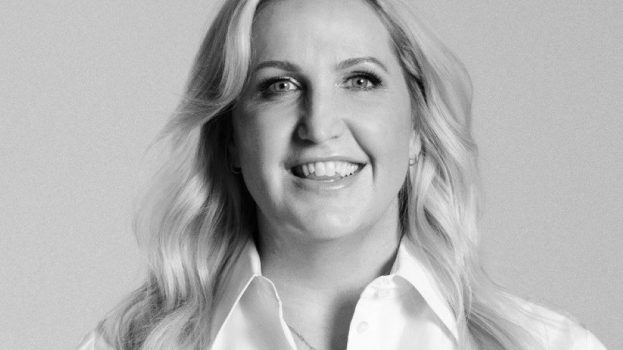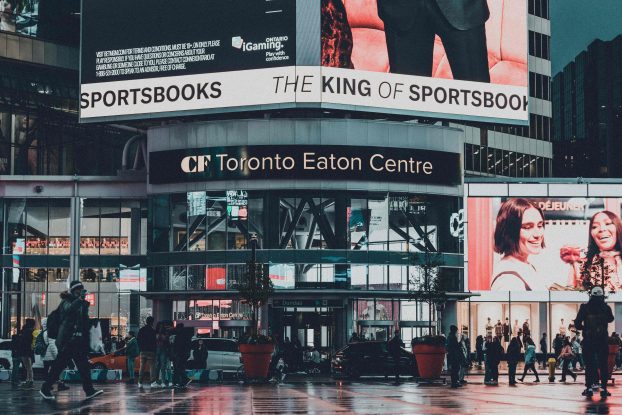In this special report, Strategy looks at the creative challenge presented by out-of-home media from a couple of perspectives.
In our opening feature, Mary Maddever interviews the sellers of outdoor, in-store and transit advertising to find out what creative opportunities presented by these media have yet to be explored.
As well, Strategy challenged eight advertising agencies to flex their creative muscle.
They were asked to show us great outdoor creative by doing it.
We set up the challenge by imagining a fictitious scenario in which the agencies were given a chance to promote themselves to new business prospects.
They were asked to imagine that a group of outdoor media companies had offered them free space in any or all of their products, as a means of encouraging them to use the medium.
Furthermore, the agencies were told the media companies were offering this space along a downtown street nicknamed ‘ClientRow’ because of the unusually high number of marketing companies with headquarters there.
Each agency was invited to develop an outdoor campaign, using any number and variation of outdoor products, to promote their own agency to these clients.
Contributors were provided one half-page each to display their campaigns.
The eight submissions appear on the top half of the page, as follows:
Palmer Jarvis p. 22; Taxi p. 23; MacLaren:Lintas p. 24; Scali, McCabe, Sloves p. 25; McCann-Erickson p. 26; Franklin Dallas p. 27; Young & Rubicam p. 30; and Saatchi & Saatchi p. 31.
Untapped creative waters
A Host of new technologies are poised to reshape the out-of-home industry.
For example, a nine-storey, 3-D multimedia walkthrough billboard is planned for erection on a vacant lot in Manhattan next year. Out-of-home media supplier Spectacolor intends to send visitors up a glass elevator, then shoo them down ramps through all manner of exhibits – all to promote a sponsor.
In the perennial quest to get a message across, every advance in communications technology can bring advertisers closer to the holy grail.
Out-of-home advertising provides fertile ground in which to develop multimedia technology into advertising hybrids.
Outdoor, in-store and transit space suppliers are investigating ways to put a spin on existing advertising vehicles and are counting on these experiments to generate renewed interest in their respective milieus.
An example of the new breed of communication conveyances is the QuickTime Festival of Festivals directory, an animated version of Toronto’s upcoming annual film festival program to be located at the box office and the festival hospitality suite.
Using touch screen technology, theatre-goers can gain access to information and mini-trailers (30-second video clips of film footage) designed to pique the interest of customers standing in line for tickets.
The directory, put together by Animatics, Toronto, is sponsored by Apple Canada.
QuickTime is just one of many interactive, low-cost tools out there waiting to be harnessed into an advertising force.
Out-of-home is also an area where untapped creative waters exist.
Murad President Michael Chesney would like to see more pure arts sponsorship, with corporations displaying original artists’ works, accompanied by discreet explanatory text offering customers art in appreciation of their patronage.
Chesney says it would be effective if done long term across Canada, envisioning artists painting murals that could remain on walls in major cities for a few years.
The increased attention drawn to the act of advertising by mainstream vehicles such as Toronto-based Citytv’s media TV has heightened awareness of advertisers’ attempts to reach them.
And that is why Chesney says a more personal non-sell approach would work – particularly for an industrial company.
He says the company could gain more from bolstering its corporate identity by improving the aesthetic environment than it could from a product ad.
Image ads for products the consumer already knows about such as beverages, are another group Chesney feels would be wise to consider art sponsorship or outlandish projects which would be more memorable than touting the product in a category in which the discernable differences are slim.
‘People would like the fact they’re putting the money into promoting someone rather than the product,’ Chesney says. ‘It builds in that long-term respect factor.
As a young country, Canada is prime for this type of promotion, according to Chesney, because company decision-makers are still accessible and open to propositions such as, one-off murals.
Even in summer, the climate leads to congregating indoors, often in large forums in need of some aesthetic bucking up.
Chesney believes the Canadian National Exhibition’s stadium exterior in Toronto could benefit from a fun architectural marketing treatment, something along the line of Murad’s windproof vinyl banner stretcher.
He sees Toronto’s SkyDome as an ideal showplace for Canadian art with the huge video screen, the Jumbotron, showing the artist at work and delivering a message from the sponsor.
Urban remural
Old gas stations that dot cottage routes, architectural leftovers of different eras, are on Chesney’s list of surfaces with mural potential.
The message would be uncomplicated, perhaps Coca Cola’s stripes wrapping the building or a logo-checkered building.
‘It’s pop art – automatically it’s wacked-out and unforgettable and you’re refurbishing these dying buildings which keep hanging around.’
The list of non-paint ingredients Chesney has considered adding to the Murad formula range from the little balloons of an air pocket vinyl treatment to neon lights, moving parts, big holograms, and the kinetic energy of an undulating 40 x 40 image made of solar ray discs – a moving piece of art powered by wind.
Chesney says whether he is putting spinning logos on the wall, or giving tired buildings a facelift, he is ‘just trying to do whatever I can to bring a smile to people’s face so they look at advertising and enjoy it.’
One only has to look at the winners of OBIE awards, showcasing excellence in outdoor advertising to know that billboards have been succeeding at that, profiting from a lot of truly creative attention.
In Vancouver, bylaws limit the imaginative lengths to which a billboard may stretch.
However, Scott Corbett, Seaboard general sales manager, says they can use a new Swedish technology that allows trio panel sections to move independently, offering a new creative challenge.
When and which way each part will turn can be predetermined and used to create a wave effect or send different messages.
Yvonne McKinnon, Mediacom vice-president, public relations, says although it is cost-prohibitive, billboards could, in theory, display different messages all day long, switched from a central computer.
Corbett says with more advertising dollars going to sales promotions, passive mediums which do not show bottom-dollar effectiveness are getting cut.
He feels billboards must become more interactive, incorporating calls to action such as 800 numbers.
Leaving the desktop behind
Combining out-of-home advertising vehicles with interactive technology gives advertisers what the consumer is doing at any given time.
Chip Graham, group product marketing manager for Apple Canada, says the introduction of products such as QuickTime brings displays that truly engage the viewer within reach.
Since commercial producers are becoming much more digital, it is practical and cost-effective to recycle material.
Graham says he would not be surprised to see on-line catalogues in stores or mall directories that respond to your search and throw in a bit of advertising.
‘Maybe even on public transit it wouldn’t be that impractical to imagine products that were more dynamic than the fixed pieces of cardboard that are there,’ Graham says.
He says the places where these new vehicles will sprout are those with the most benefit to the consumer, such as interactive information kiosks which could easily contain little QuickTime movie ads.
Imagine you need to choose a place to eat. The menu plus a 30-second video clip pop up. It is pricey, so you sidle over to a bank machine. Out pops money. So why not conduct a major awareness campaign through bank machines?
Coupons or contest entry forms or just plain advertising could tag on to transaction statements, perhaps targetted through withdrawal levels.
Soundselling
Radio is arguably an out-of-home contender, and when you tailor it to a specific category of chain stores, that is hitting the target
Storecast is a new national satellite-delivered in-store audio system that tags 12 minutes of advertising on every hour of its continuous soft rock.
Kirk Shearer, executive vice-president of Telemedia Procom, says the new MediaSat Storecast Network may sound like radio but its impact is as a P-O-P vehicle and, as such, has little in common with radio spots.
Storecast launched its drug network in January (which was sold out), and its grocery network launches in September.
Shearer says advertisers are demanding measurable results, and since Storecast-advertised brands recorded a 13% sales lift, related potential growth areas are being explored.
‘We’re reviewing a variety of other satellite and non-satellite delivered promotional opportunities,’ says Shearer, adding that because of the satellite delivery system other in-store media down the road could include high definition TV.
shelfLife
At infoNet Media, the in-store specialists believe in ‘smart tech.’
Bruce Goldstein, vice-president of marketing and strategic development, says the goal is to find ways to challenge the senses, but that interactivity need not mean high tech. It can be as simple as a shelftalker that lets you feel a sample of a new product.
Lately infoShelf displays have gone beyond the rectangular, and taken on unusual shapes (including a 3-D toilet). InfoNet has also tested backlit infoCentres which will launch in January.
Goldstein says the primary goal is to integrate in-store with mainstream marketing and create the types of in-store vehicles customers will need.
InfoNet is looking at providing sound (in a vein similar to Storecast), in tandem with in-store displays to create a multimedia marketing environment.
On the road to an integrated network, infoNet formed an alliance with Maclean Hunter to build packages for magazines and in-store that provide the advertiser with consistent and cost-effective message delivery.
Transitions
TransAd President Ron Hutchinson says the boundaries are also opening up for transit advertising.
While approval for going beyond traditional exterior bus poster size is still on a per project basis, Hutchinson says it appears it is not going to be a problem.
And new material has made it technically possible to cover windows; Contra Vision can have different designs printed on each side, and be seen through.
Hutchinson sees it as a chance for advertisers to catch and hold attention, and adds that Holoprism is another promising new material; it refracts light and the colors change.
Interior ad shapes are also changing, like the OBIE-winning 30-foot-long snake for Toronto’s Royal Ontario Museum.
Publicite Metrobus President Robert Lacas is also looking at ways of making the product less static.
‘This is the future, more movement and light,’ Lacas says. ‘We have to come up with something to allow more impactful creative.’
A digital image-carrying version of the Metron could be in the future.
Hutchinson says that particularly in the high traffic stations, there is a big enough audience to support new technologically-driven media.
He says later generation information delivery systems are being tested, some of which can be programmed with a paging system from another province and changed quickly to create a more flexible, time-sensitive vehicle.
Backlit boxes are slated for installation at Toronto’s Yonge and Bloor subway station this fall. Once electricity is in there, benchmark creative possibilities could follow, neon sculpture, moving parts, recorded sound.
The alchemy of idea and technology can deliver capability, but it is up to the creative to put out-of-home top-of-mind.























